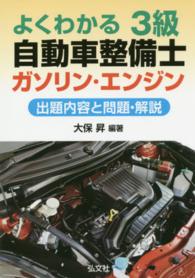- ホーム
- > 洋書
- > 英文書
- > History / World
Full Description
This book explores routes of interaction and exchange in the Southern Maya Area, a zone that had both short- and long-distance trade and whose natural resources were exploited by merchants and rulers, colonists and entrepreneurs during Olmec, Teotihuacan, Maya, Aztec, colonial and modern times.
The book presents the research of both archaeologists and art historians to identify routes of interconnection, to demonstrate the strategic importance of settlements and ritual locations, and to assess the significance of modes and mediums of exchange. The contributors employ innovative approaches, making use of state-of-the art technologies to reproduce and analyze the archaeological landscape (e.g. LiDAR, GIS, and least-cost path analysis) and to source and characterize archaeological materials (e.g. neutron activation analysis (NAA), X-ray fluorescence analysis [XRF] and strontium analysis). The book combines these innovative approaches with earlier data sources and past analyses to develop a new, synthetic analysis of interaction.
Routes, Interaction and Exchange in the Southern Maya Area will appeal to professional academics, students, and interested lay readers from a broad range of social science fields including anthropology, archaeology, geography, economics, history, and art history and is appropriate for undergraduate and graduate courses in Mesoamerican archaeology.
Contents
1. Introduction to Routes, Interaction and Exchange; Part I: Hubs, Networks and Economies of the Preclassic Period; 2. Chiapa de Corzo: Exchange Routes and Cultural Interaction between Zoque and Maya Regions; 3. Tak'alik Ab'aj and its Neighbors in the Network of the Ritual Market Economy; 4. Izapa and the Formative Period Kingdoms of Southern Pacific Mesoamerica; Part II: Routes, Interaction and Exchange during the Classic Period; 5. About-Faces: Stylistic Evolutions and Interactions at Kaminaljuyu, Guatemala; 6. Interaction and Ideology: The Teotihuacan-Style Censers from the Pacific Coast of Guatemala; 7. Long-Distance Exchange and the Ballgame at Kaminaljuyu; 8. "The Mountain Trails are Well Traveled": Routes and Economic Organization in the Lake Atitlan Basin; 9. Least-Cost Routes and the Kaqchikel Maya Region: Intercommunity Trade, Movement and Communication; 10. American Pompeii: Old Evidence on Late Classic Ties between the Pacific Coast and the Antigua Valley; 11. Raxruha Viejo and Highland-Lowland Interaction during the Classic Period; 12. Tracking Trade: Explaining the Rise of Copan's Polity in Southeastern Mesoamerica; Part III: Production, Trade and Migration in the Postclassic Period; 13. Export Craft Production in Soconusco: An Update on Tohil Plumbate; 14. Trade, Migration, and Continuity at Plumbate Era Izapa; 15. lnteraction and Exchange in Late Postclassic Xoconochco; 16. An Uphill View of the Northern Guatemalan Highlands from the Southern Maya Lowlands








